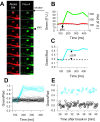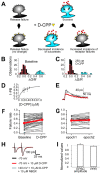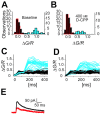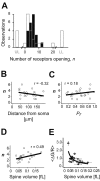The number of glutamate receptors opened by synaptic stimulation in single hippocampal spines
- PMID: 14985448
- PMCID: PMC6730404
- DOI: 10.1523/JNEUROSCI.5066-03.2004
The number of glutamate receptors opened by synaptic stimulation in single hippocampal spines
Abstract
The number of receptors opening after glutamate release is critical for understanding the sources of noise and the dynamic range of synaptic transmission. We imaged [Ca2+] transients mediated by synaptically activated NMDA receptors (NMDA-Rs) in individual spines in rat brain slices. We show that Ca2+ influx through single NMDA-Rs can be reliably detected, allowing us to estimate the number of receptors opening after synaptic transmission. This number is small: at the peak of the synaptic response, less than one NMDA-R is open, on average. Therefore, stochastic interactions between transmitter and receptor contribute substantially to synaptic noise, and glutamate occupies a small fraction of receptors. The number of receptors opening did not scale with spine volume, and smaller spines experience larger [Ca2+] transients during synaptic transmission. Our measurements further demonstrate that optical recordings can be used to study single receptors in intact systems.
Figures








Similar articles
-
Synaptic calcium transients in single spines indicate that NMDA receptors are not saturated.Nature. 1999 May 13;399(6732):151-5. doi: 10.1038/20187. Nature. 1999. PMID: 10335844
-
Evidence for low GluR2 AMPA receptor subunit expression at synapses in the rat basolateral amygdala.J Neurochem. 2005 Sep;94(6):1728-38. doi: 10.1111/j.1471-4159.2005.03334.x. Epub 2005 Jul 25. J Neurochem. 2005. PMID: 16045445 Free PMC article.
-
Creation of AMPA-silent synapses in the neonatal hippocampus.Nat Neurosci. 2004 Mar;7(3):236-43. doi: 10.1038/nn1196. Epub 2004 Feb 15. Nat Neurosci. 2004. PMID: 14966524
-
Regulation of synaptic signalling by postsynaptic, non-glutamate receptor ion channels.J Physiol. 2008 Mar 15;586(6):1475-80. doi: 10.1113/jphysiol.2007.148353. Epub 2007 Dec 20. J Physiol. 2008. PMID: 18096597 Free PMC article. Review.
-
Extracellular glutamate diffusion determines the occupancy of glutamate receptors at CA1 synapses in the hippocampus.Philos Trans R Soc Lond B Biol Sci. 1999 Feb 28;354(1381):395-402. doi: 10.1098/rstb.1999.0392. Philos Trans R Soc Lond B Biol Sci. 1999. PMID: 10212489 Free PMC article. Review.
Cited by
-
Remodeling of dendrites and spines in the C1q knockout model of genetic epilepsy.Epilepsia. 2013 Jul;54(7):1232-9. doi: 10.1111/epi.12195. Epub 2013 Apr 26. Epilepsia. 2013. PMID: 23621154 Free PMC article.
-
Voltage and calcium transients in basal dendrites of the rat prefrontal cortex.J Physiol. 2007 Dec 1;585(Pt 2):447-68. doi: 10.1113/jphysiol.2007.142315. Epub 2007 Oct 11. J Physiol. 2007. PMID: 17932150 Free PMC article.
-
Quantal size is independent of the release probability at hippocampal excitatory synapses.J Neurosci. 2005 Jan 5;25(1):223-32. doi: 10.1523/JNEUROSCI.3688-04.2005. J Neurosci. 2005. PMID: 15634785 Free PMC article.
-
From synaptically localized to volume transmission by nitric oxide.J Physiol. 2016 Jan 1;594(1):9-18. doi: 10.1113/JP270297. Epub 2015 Nov 18. J Physiol. 2016. PMID: 26486504 Free PMC article. Review.
-
Postsynaptic localization and regulation of AMPA receptors and Cav1.2 by β2 adrenergic receptor/PKA and Ca2+/CaMKII signaling.EMBO J. 2018 Oct 15;37(20):e99771. doi: 10.15252/embj.201899771. Epub 2018 Sep 24. EMBO J. 2018. PMID: 30249603 Free PMC article. Review.
References
-
- Bading H, Ginty DD, Greenberg ME (1993) Regulation of gene expression in hippocampal neurons by distinct calcium signaling pathways. Science 260: 181-186. - PubMed
-
- Bekkers JM, Stevens CF (1989) NMDA and non-NMDA receptors are co-localized at individual excitatory synapses in cultured rat hippocampus. Nature 341: 230-233. - PubMed
-
- Casado M, Isope P, Ascher P (2002) Involvement of presynaptic N-methyl-d-aspartate receptors in cerebellar long-term depression. Neuron 33: 123-130. - PubMed
Publication types
MeSH terms
Substances
LinkOut - more resources
Full Text Sources
Miscellaneous
